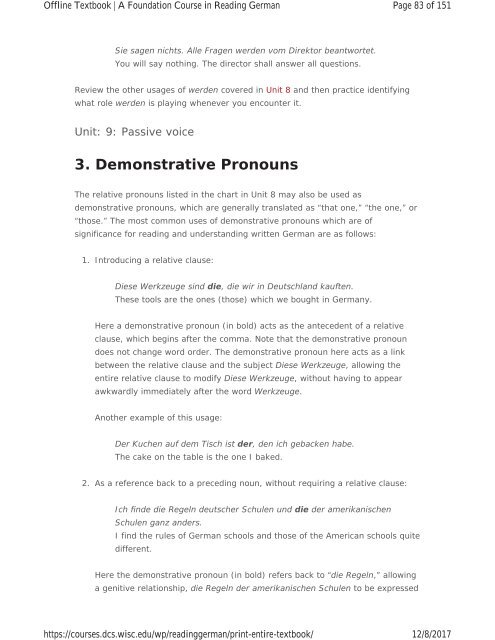A Foundation Course in Reading German, 2017a
A Foundation Course in Reading German, 2017a
A Foundation Course in Reading German, 2017a
Create successful ePaper yourself
Turn your PDF publications into a flip-book with our unique Google optimized e-Paper software.
Offl<strong>in</strong>e Textbook | A <strong>Foundation</strong> <strong>Course</strong> <strong>in</strong> Read<strong>in</strong>g <strong>German</strong><br />
https://courses.dcs.wisc.edu/wp/read<strong>in</strong>ggerman/pr<strong>in</strong>t-entire-textbook/<br />
Page 83 of 151<br />
12/8/2017<br />
Sie sagen nichts. Alle Fragen werden vom Direktor beantwortet.<br />
You will say noth<strong>in</strong>g. The director shall answer all questions.<br />
Review the other usages of werden covered <strong>in</strong> Unit 8 and then practice identify<strong>in</strong>g<br />
what role werden is play<strong>in</strong>g whenever you encounter it.<br />
Unit: 9: Passive voice<br />
3. Demonstrative Pronouns<br />
The relative pronouns listed <strong>in</strong> the chart <strong>in</strong> Unit 8 may also be used as<br />
demonstrative pronouns, which are generally translated as “that one,” “the one,” or<br />
“those.” The most common uses of demonstrative pronouns which are of<br />
significance for read<strong>in</strong>g and understand<strong>in</strong>g written <strong>German</strong> are as follows:<br />
1. Introduc<strong>in</strong>g a relative clause:<br />
Diese Werkzeuge s<strong>in</strong>d die, die wir <strong>in</strong> Deutschland kauften.<br />
These tools are the ones (those) which we bought <strong>in</strong> <strong>German</strong>y.<br />
Here a demonstrative pronoun (<strong>in</strong> bold) acts as the antecedent of a relative<br />
clause, which beg<strong>in</strong>s after the comma. Note that the demonstrative pronoun<br />
does not change word order. The demonstrative pronoun here acts as a l<strong>in</strong>k<br />
between the relative clause and the subject Diese Werkzeuge, allow<strong>in</strong>g the<br />
entire relative clause to modify Diese Werkzeuge, without hav<strong>in</strong>g to appear<br />
awkwardly immediately after the word Werkzeuge.<br />
Another example of this usage:<br />
Der Kuchen auf dem Tisch ist der, den ich gebacken habe.<br />
The cake on the table is the one I baked.<br />
2. As a reference back to a preced<strong>in</strong>g noun, without requir<strong>in</strong>g a relative clause:<br />
Ich f<strong>in</strong>de die Regeln deutscher Schulen und die der amerikanischen<br />
Schulen ganz anders.<br />
I f<strong>in</strong>d the rules of <strong>German</strong> schools and those of the American schools quite<br />
different.<br />
Here the demonstrative pronoun (<strong>in</strong> bold) refers back to “die Regeln,” allow<strong>in</strong>g<br />
a genitive relationship, die Regeln der amerikanischen Schulen to be expressed


















